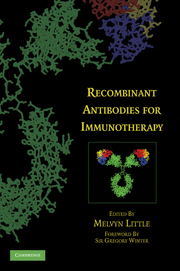Book contents
- Frontmatter
- Contents
- Contributors
- Foreword by Sir Gregory Winter
- Preface
- RECOMBINANT ANTIBODIES FOR IMMUNOTHERAPY
- PART I HUMANIZED ANTIBODIES
- 1 Humanization of Recombinant Antibodies
- 2 Immunogenicity Assessment of Antibody Therapeutics
- 3 In Vitro Screening for Antibody Immunogenicity
- PART II GENERATION AND SCREENING OF ANTIBODY LIBRARIES
- PART III TRANSGENIC HUMAN ANTIBODY REPERTOIRES
- PART IV ANTIBODY EFFECTOR FUNCTION
- PART V ARMING ANTIBODIES
- PART VI NOVEL ANTIBODY FORMATS
- PART VII ANTIGEN-BINDING REPERTOIRES OF NON-IMMUNOGLOBULIN PROTEINS
- PART VIII PROLONGATION OF SERUM HALF-LIFE
- PART IX INNOVATIVE IMMUNOTHERAPEUTIC APPROACHES
- PART X MARKET OVERVIEW AND OUTLOOK
- Index
- Plate section
- References
2 - Immunogenicity Assessment of Antibody Therapeutics
from PART I - HUMANIZED ANTIBODIES
Published online by Cambridge University Press: 15 December 2009
- Frontmatter
- Contents
- Contributors
- Foreword by Sir Gregory Winter
- Preface
- RECOMBINANT ANTIBODIES FOR IMMUNOTHERAPY
- PART I HUMANIZED ANTIBODIES
- 1 Humanization of Recombinant Antibodies
- 2 Immunogenicity Assessment of Antibody Therapeutics
- 3 In Vitro Screening for Antibody Immunogenicity
- PART II GENERATION AND SCREENING OF ANTIBODY LIBRARIES
- PART III TRANSGENIC HUMAN ANTIBODY REPERTOIRES
- PART IV ANTIBODY EFFECTOR FUNCTION
- PART V ARMING ANTIBODIES
- PART VI NOVEL ANTIBODY FORMATS
- PART VII ANTIGEN-BINDING REPERTOIRES OF NON-IMMUNOGLOBULIN PROTEINS
- PART VIII PROLONGATION OF SERUM HALF-LIFE
- PART IX INNOVATIVE IMMUNOTHERAPEUTIC APPROACHES
- PART X MARKET OVERVIEW AND OUTLOOK
- Index
- Plate section
- References
Summary
With over 20 therapeutic antibodies currently approved by the Food and Drug Administration (FDA) and close to 100 leads in clinical trials, therapeutic antibodies are responsible for a considerable part of the therapeutic proteins sales worldwide. The observation of immunogenicity with the early therapeutic antibodies did not come as a surprise, as many of them were murine antibodies or chimeric variants, consisting of murine variable parts in conjunction with a human constant domain. Over time, there has been a strong evolution toward the development of humanized and fully human antibodies, thereby reducing the observed immunogenicity to a significant extent. General side effects such as anaphylaxis and allergy against protein therapeutics are also less prevalent but this is due to better manufacturing processes giving more homogeneous products.
However, some of the currently available fully human antibodies have induced significant immunogenic responses over time. This has led to the regulatory instances in Europe and the United States supporting the development of guidelines to assess the likelihood of observing immunogenicity and its potential severity and side effects.
IMMUNOGENICITY DRIVERS
Several factors contribute to the potential immunogenicity of a protein therapeutic:
Homology to human or endogenous proteins: The degree of “foreignness” of a protein to the host is one of the major contributors to an immune response. Indeed, the likelihood to observe immunogenicity related to a bacterium-derived protein therapeutic, such as staphylokinase, is higher than against proteins that show high homology to endogenous proteins, such as erythropoietin (EPO) and insulin. The overall immunogenicity of antibody therapeutics has been severely reduced by the development of fully human and humanized therapeutic antibodies as compared to the first-generation murine and chimeric antibodies (Hwang and Foote, 2005).
[…]
- Type
- Chapter
- Information
- Recombinant Antibodies for Immunotherapy , pp. 20 - 42Publisher: Cambridge University PressPrint publication year: 2009

